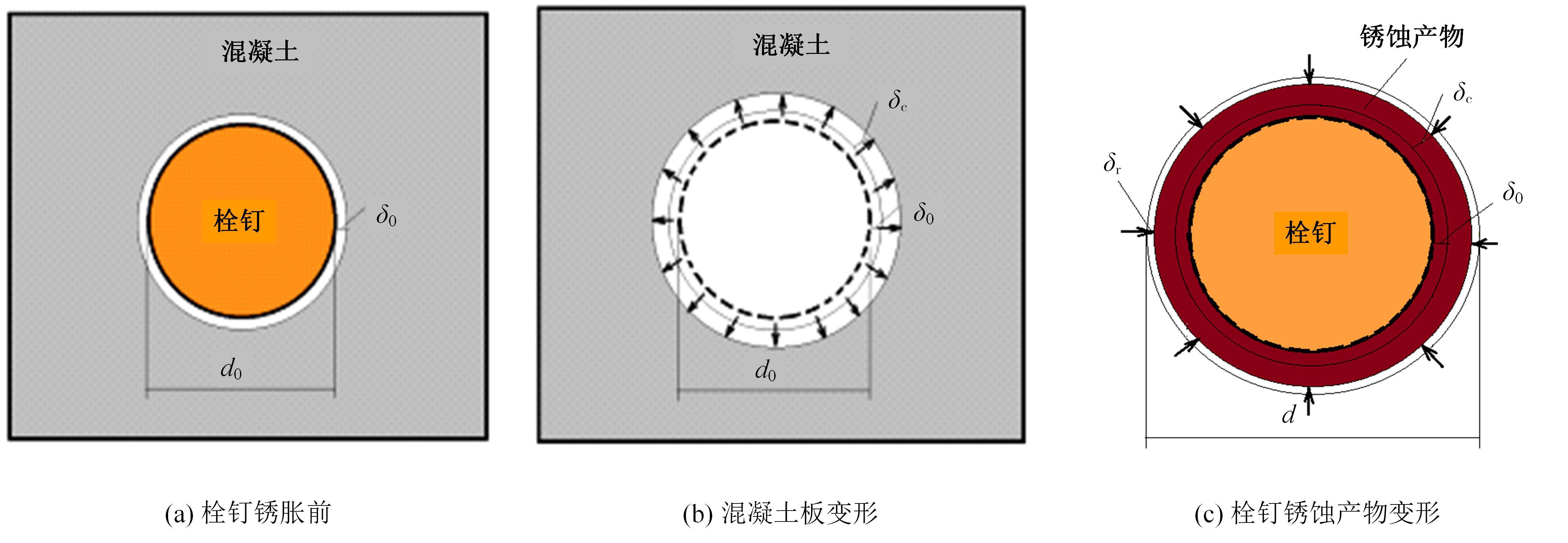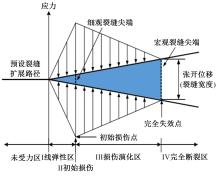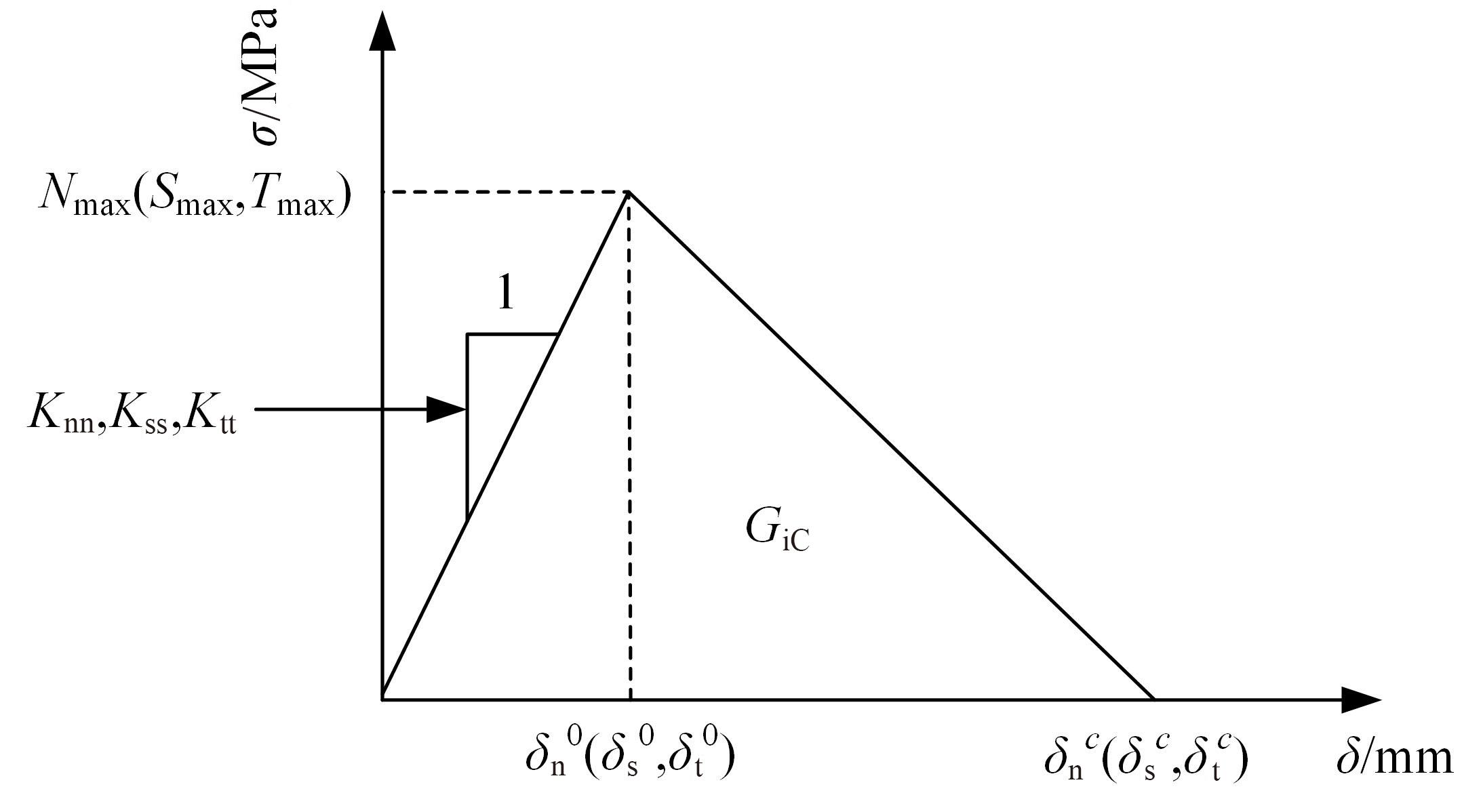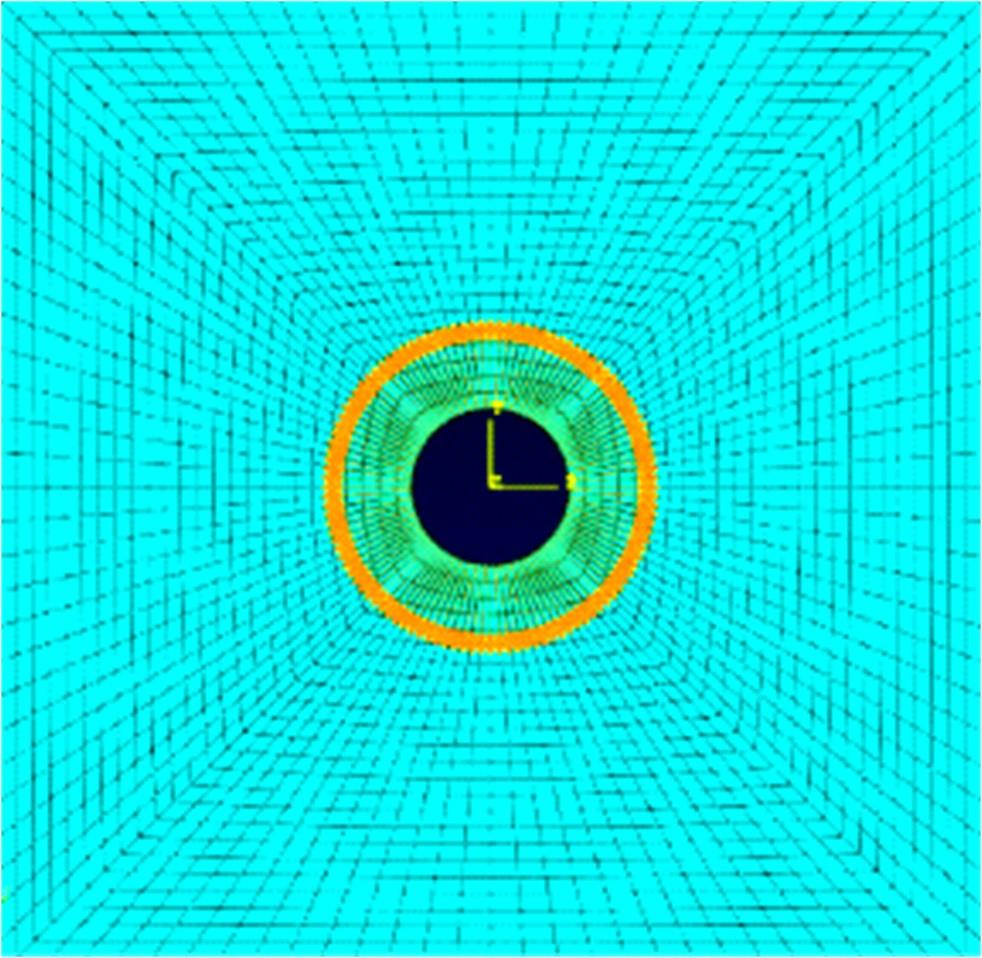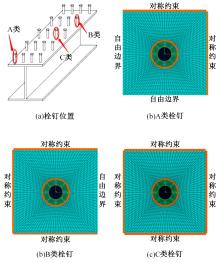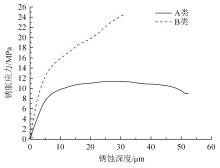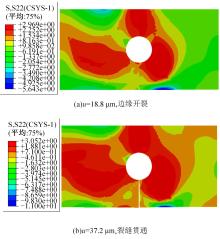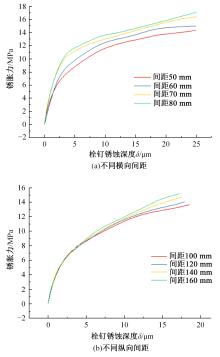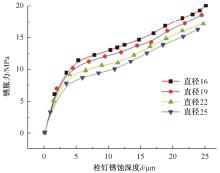Journal of Jilin University(Engineering and Technology Edition) ›› 2024, Vol. 54 ›› Issue (7): 1958-1965.doi: 10.13229/j.cnki.jdxbgxb.20221195
Numerical analysis on cracking behavior of concrete slab due to corrosion expansion of stud connector in steel-concrete composite beam
Lin XIAO( ),Huan-bo WEI,Xing WEI(
),Huan-bo WEI,Xing WEI( ),Zhi-rui KANG
),Zhi-rui KANG
- School of Civil Engineering,Southwest Jiaotong University,Chengdu 610031,China
CLC Number:
- TU398.9
| 1 | 卫星,肖林,温宗意,等.钢-混组合结构桥梁2020年度研究进展[J]. 土木与环境工程学报, 2021,43():107-119. |
| Wei Xing, Xiao Lin, Wen Zong-yi,et al. Research progress of steel-concrete composite bridges in 2020 [J]. Journal of Civil and Environmental Engineering, 2021,43(Sup.1): 107-119. | |
| 2 | 魏欢博. 腐蚀环境下钢-混结合梁栓钉连接件服役性能退化规律研究[D].成都:西南交通大学土木工程学院, 2021. |
| Wei Huan-bo. Degradation law of service performance of steel-concrete beam stud connectors in corrosive environment[D]. Chengdu: School of Civil Engineering,Southwest Jiaotong University, 2021. | |
| 3 | Bhargava K, Ghosh A K, Mori Y, et al. Modeling of time to corrosion-induced cover cracking in reinforced concrete structures[J]. Cement and Concrete Research, 2005, 35(11):2203-2218. |
| 4 | 王海龙,金伟良,孙晓燕.基于断裂力学的钢筋混凝土保护层锈胀开裂模型[J].水利学报,2008, 39(7) : 863-869. |
| Wang Hai-long, Jin Wei-liang, Sun Xiao-yan. Fracture model for protective layer cracking of reinforced concrete structure due to rebar corrosion[J]. Journal of Hydraulic Engineering, 2008, 39(7):863-869. | |
| 5 | 周锡武,卫军,徐港.钢筋混凝土保护层锈胀开裂的临界锈蚀量模型[J].武汉理工大学学报,2009,31(12):99-102. |
| Zhou Xi-wu, Wei Jun, Xu Gang. Bar critical corrosion ratio model of reinforcement concrete cover corrosion expanding crack[J]. Journal of Wuhan University of Technology, 2009,31(12): 99-102. | |
| 6 | 陈海忠,曹龙飞,张华,等.混凝土锈胀开裂的断裂过程分析[J].华中科技大学学报:自然科学版,2010,38(9):101-103. |
| Chen Hai-zhong, Cao Long-fei, Zhang Hua, et al. Analysis of breaking-down process of rebars corrosion expansion cracking in reinforce concrete[J]. Journal of Huazhong University of Science and Technology, 2010,38(9):101-103. | |
| 7 | 林刚,向志海,刘应华.钢筋混凝土保护层锈胀开裂时间预测模型[J].清华大学学报:自然科学版,2010,50(7): 1125-1129. |
| Lin Gang, Xiang Zhi-hai, Liu Ying-hua. Modeling of time to corrosion cracking in reinforced concrete structures[J]. Journal of Tsinghua University, 2010, 50(7): 1125-1129. | |
| 8 | Bossio A, Monetta T, Bellucci F, et al. Modeling of concrete cracking due to corrosion process of reinforcement bars [J]. Cement and Concrete Research, 2015, 71:78-92. |
| 9 | Lu C H, Yuan S Q, Liu R G. Experimental and probabilistic analysis of time to corrosion-induced cover cracking for marine reinforced concrete structures[J]. Corrosion Engineering, Science and Technology, 2017, 52(2):124-133. |
| 10 | Zhang X G, Li M H, Tang L P, et al. Corrosion induced stress field and cracking time of reinforced concrete with initial defects: analytical modeling and experimental investigation[J]. Corrosion Science, 2017, 120:158-170. |
| 11 | 伦培元, 张小刚, 张强,等. 基于初始缺陷形状的混凝土结构锈胀开裂理论模型[J]. 东北大学学报:自然科学版, 2020, 41(7):1020-1026. |
| Pei-yuan Lun, Zhang Xiao-gang, Zhang Qiang, et al. Theoretical model of rust expansion cracking of concrete structure based on the initial defect shape[J]. Journal of Northeastern University, 2020, 41(7):1020-1026. | |
| 12 | 方建柯,徐亦冬,徐立锋,等.环境-荷载耦合作用下钢筋锈蚀产物的分子动力学模拟及其锈胀力分析[J].硅酸盐通报,2018,37(10):3275-3280. |
| Fang Jian-ke, Xu Yi-dong, Xu Li-feng, et al. Molecular dynamics simulation and corrosion expansion analysis of reinforcement corrosion products under coupled effect of chloride and loading[J]. Bulletin of the Chinese Ceramic Society, 2018,37(10):3275-3280. | |
| 13 | 胡志坚,夏雷雷,程晨,等.钢筋混凝土构件锈蚀开裂与锈胀力分析[J].哈尔滨工业大学学报,2020, 52(3): 99-105. |
| Hu Zhi-jian, Xia Lei-lei, Cheng Chen. Investigation on corrosion-induced cracking and corrosion expansive pressure in reinforced concrete members[J]. Journal of Harbin Institute of Technology, 2020, 52(3): 99-105. | |
| 14 | 金波,孙楠,方棋洪,等.混凝土构件中钢筋非均匀锈胀力研究[J].固体力学学报,2022,43(4): 456-466. |
| Jin Bo, Sun Nan, Fang Qi-hong, et al. Research on non-uniform corrosion expansion stress of reinforcing bars in concrete members[J]. Chinese Journal of Solid Mechanics, 2022,43(4): 456-466. |
| [1] | Chun-lei ZHANG,Chang-yu SHAO,Qing-tian SU,Chang-yuan DAI. Experimental on positive bending behaviour of composite bridge decks with steel-fiber-reinforced concrete and longitudinal bulb-flat ribs [J]. Journal of Jilin University(Engineering and Technology Edition), 2024, 54(6): 1634-1642. |
| [2] | Ya-zhen SUN,Bo-xin XUE,Yan SUN,Zhi-chen WANG,Jia-wei PAN. Mesoscale simulation of cracking behavior of asphalt mixture considering heterogeneity [J]. Journal of Jilin University(Engineering and Technology Edition), 2024, 54(6): 1708-1718. |
| [3] | Han-hui HUANG,Kang-ming CHEN,Qing-xiong WU. Flexural behavior of composite continuous girders with concrete-filled steel tubular truss chords [J]. Journal of Jilin University(Engineering and Technology Edition), 2024, 54(6): 1665-1676. |
| [4] | Chang-jiang SHAO,Hao-meng CUI,Qi-ming QI,Wei-lin ZHUANG. Longitudinal seismic mitigation of near⁃fault long⁃span RC soft⁃lighten arch bridge based on viscous damper [J]. Journal of Jilin University(Engineering and Technology Edition), 2024, 54(5): 1355-1367. |
| [5] | Tong-tong WAN,Hai-nian WANG,Wen-hua ZHENG,Po-nan FENG,Yu CHEN,Chen ZHANG. Thermal contraction deformation behavior of asphalt mixture overlay with coordination of unbound aggregate layer [J]. Journal of Jilin University(Engineering and Technology Edition), 2024, 54(4): 1045-1057. |
| [6] | Qiu ZHAO,Peng CHEN,Yu-wei ZHAO,Ao YU. Overall mechanical performance of jointless bridges with arch structure behind abutment [J]. Journal of Jilin University(Engineering and Technology Edition), 2024, 54(4): 1016-1027. |
| [7] | Hong ZHANG,Zhi-wei ZHU,Tian-yu HU,Yan-feng GONG,Jian-ting ZHOU. Bridge bolt defect identification method based on improved YOLOv5s [J]. Journal of Jilin University(Engineering and Technology Edition), 2024, 54(3): 749-760. |
| [8] | Zhi-qiang HAN,Gang XIE,Ya-juan ZHUO,Zuo-long LUO,Hua-teng LI. Vibration response of continuous girder bridge based on wheel⁃deck coherent excitation [J]. Journal of Jilin University(Engineering and Technology Edition), 2024, 54(2): 436-444. |
| [9] | Guo-jun YANG,Ya-hui QI,Xiu-ming SHI. Review of bridge crack detection based on digital image technology [J]. Journal of Jilin University(Engineering and Technology Edition), 2024, 54(2): 313-332. |
| [10] | Guo-jin TAN,Ji OU,Yong-ming AI,Run-chao YANG. Bridge crack image segmentation method based on improved DeepLabv3+ model [J]. Journal of Jilin University(Engineering and Technology Edition), 2024, 54(1): 173-179. |
| [11] | Guan-xu LONG,Xiu-shi ZHANG,Gong-feng XIN,Tao WANG,Gan YANG. Bridge weigh-in-motion combined with machine version [J]. Journal of Jilin University(Engineering and Technology Edition), 2024, 54(1): 188-197. |
| [12] | Xing WEI,Ya-jie GAO,Zhi-rui KANG,Yu-chen LIU,Jun-ming ZHAO,Lin XIAO. Numerical simulation of residual stress field of stud girth weld in low temperature environment [J]. Journal of Jilin University(Engineering and Technology Edition), 2024, 54(1): 198-208. |
| [13] | Ran AN,You-zhi WANG. Shear properties of shear stud connectors under combined tension and shear loading [J]. Journal of Jilin University(Engineering and Technology Edition), 2023, 53(9): 2554-2562. |
| [14] | Xin-dai ZUO,Jin-quan ZHANG,Shang-chuan ZHAO. Fatigue stiffness degradation and life prediction method of in⁃service concrete T⁃beams [J]. Journal of Jilin University(Engineering and Technology Edition), 2023, 53(9): 2563-2572. |
| [15] | Zheng-wei GU,Pan ZHANG,Dong-ye LYU,Chun-li WU,Zhong YANG,Guo-jin TAN,Xiao-ming HUANG. Earthquake⁃induced residual displacement analysis of simply supported beam bridge based on numerical simulation [J]. Journal of Jilin University(Engineering and Technology Edition), 2023, 53(6): 1711-1718. |
|
||

